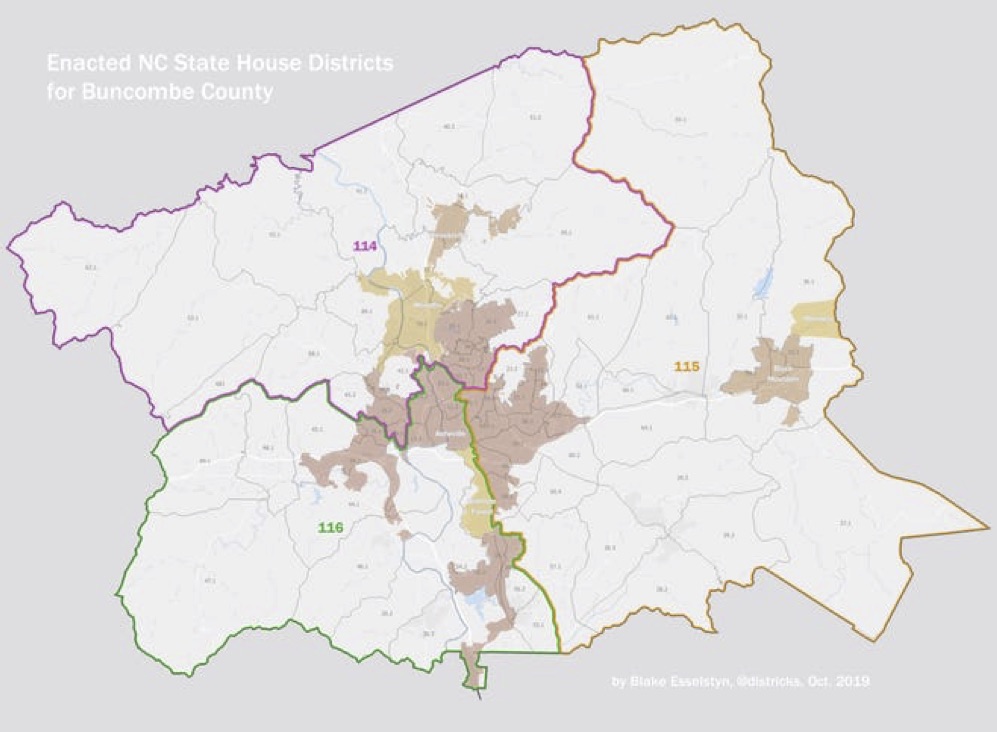- One 2019 lawsuit successfully changed Asheville being packed into one district, while another 2019 lawsuit successfully challenged Asheville being split across districts
- Buncombe County will have three North Carolina House districts, and either packing Asheville into one district or spreading it across three could subject the map to a lawsuit
- A compromise would be to have most of Asheville split between two House districts while having the third district represent rural parts of Buncombe County
This article is part of a limited series of research briefs demonstrating the ways law and geography constrain how legislators can draw North Carolina’s General Assembly districts.
The first research brief in this series dealt with how a grouping of 17 counties would require that legislators split Caldwell County. The second brief noted how political geography would make it impossible for legislators to follow all their redistricting criteria when drawing North Carolina Senate districts in the county cluster of Cumberland and Moore counties.
This brief will demonstrate that legislators can face difficulties even when drawing legislative maps within individual counties. No county better exemplifies that problem than does Buncombe.
A progressive island subject to lawsuits for opposite reasons
Buncombe is by far the most populous county in North Carolina’s mountains. Much of that population is in Asheville, a progressive stronghold in the center of the county. As will be seen, its position in the county (see Figure 1) means that Asheville voters are either packed or cracked apart when drawing districts within the county.
Figure 1: Map of Buncombe County showing current North Carolina House Districts (Asheville is the purple section in the middle of the map, extending to the county’s southern border)

Source: Blake Esselstyn via the Citizen-Times
Asheville was part of two redistricting lawsuits in 2019, but for opposite reasons. In Common Cause v. Lewis, plaintiffs complained that Asheville was unfairly packed together in one North Carolina House district, making the other two districts in Buncombe County close to evenly divided between Republicans and Democrats. The court agreed, calling the three-district grouping “an extreme partisan gerrymander” (page 220). Under court-ordered redistricting, the legislature cracked Asheville across the three House districts, making all of them safe seats for Democrats.
In a second 2019 lawsuit, Harper v. Lewis, Democrats complained that a Congressional redistricting plan “egregiously cracks Asheville’s Democratic voters between Districts 10 and 11 to create two safe Republican seats.” The court agreed, and the General Assembly had to redraw the map to unite Asheville within a single Congressional district.
Back to the well: Pack Asheville or crack it?
The General Assembly is back to redistricting and must complete it before candidate filing in early December. Buncombe County will again have three House districts in the current round of redistricting. That means legislators will face the same questions about packing or cracking Asheville.
The first option, depicted in Figure 2, would unite most of Asheville within a single district. While that was the arrangement that a court overturned in Common Cause v. Lewis, part of the reason for that ruling was that the court specifically chose not to “give weight to any nonpartisan explanation Legislative Defendants offered with respect to the boundaries of these districts” (page 221). The General Assembly specifically included considerations of municipal boundaries and communities of interest in its redistricting criteria this year, however.
Figure 2: Three Buncombe NC House districts with most of Asheville united in the 114th District

The 114th District would be safely Democratic, the 115th would lean Democratic, and the 116th would lean Republican.
As seen in Figure 3, the next option is to recreate the current map that cracks Asheville across the three districts. All three districts would be safely Democratic.
Figure 3: Three Buncombe NC House districts with Asheville split between them

A third way to redistrict Buncombe County
There is an additional twist to redistricting in Buncombe County that could lead to another lawsuit. The county’s three commissioner districts matched its three North Carolina House districts and changed with the 2019 court order. As seen in the 2020 election, the result is that Republican voters — despite comprising about 40% of the county’s electorate — will not be able to elect any candidates of their choice to the Buncombe County Board of Commissioners if Asheville continues to be cracked across the three districts. That may leave the county vulnerable to a lawsuit from Republicans who claim that cracking Asheville violates their right to free and fair elections based on the logic of Common Cause v. Lewis and Harper v. Lewis.
There is a third option, depicted in Figure 4. It would split most of Asheville between two House districts while preserving the third district to represent rural areas in western and northern Buncombe County.
Figure 4: Three Buncombe NC House districts with Asheville split between the 114th and the 115th

The 114th and 115th districts would be safely Democratic, while the 116th would lean Republican.
As with most compromises, people on both sides would not be completely satisfied with that map. But it may be the best option for balancing the competing interests and criteria for drawing NC House and county commission districts in Buncombe County.


